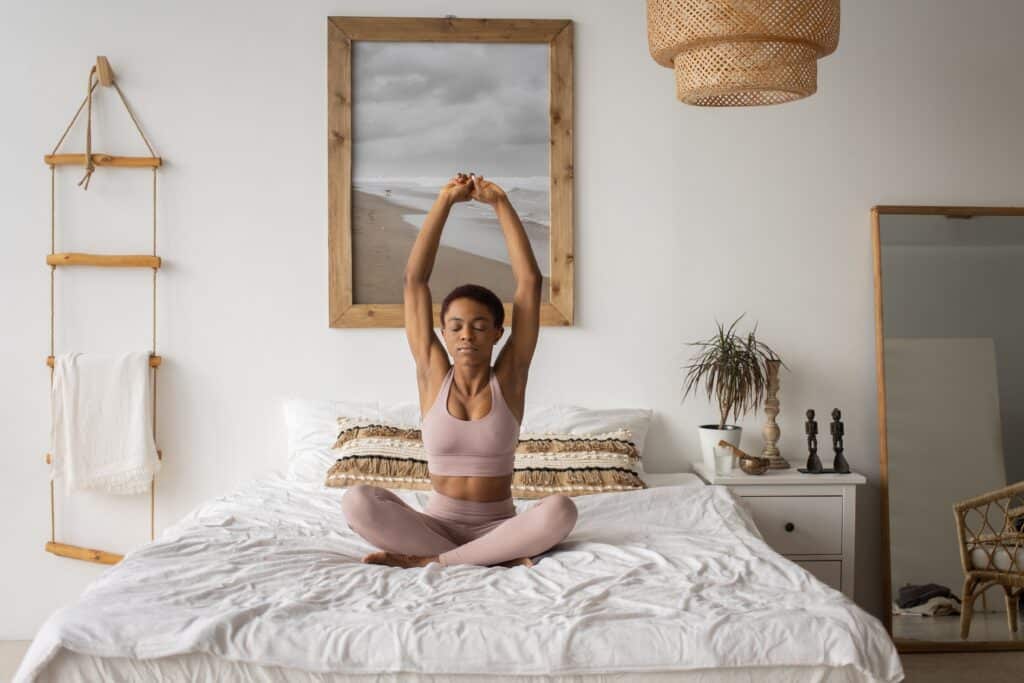Are you tired of tossing and turning despite trying various sleep aids? Insomnia is no joke, and the mission to successfully acquire a good night’s sleep can often be elusive, frustrating, and completely day-ruining. But what about bedtime yoga? This practice can serve double-duty as a wonderful way to prepare you for sleep as well as enhancing your overall well-being. The way you’re feeling in body and mind plays the biggest part in your ability to fall (and stay) asleep, and relaxing yoga can be one of the best tools to help you shift states, both mentally and physically, to encourage a long and peaceful slumber.

How yoga impacts sleep
Scientific research has shown that incorporating yoga into your bedtime routine can significantly improve sleep quality. A study conducted on individuals aged 65 and older revealed that regular yoga practitioners experienced better sleep quality, quicker sleep onset, and fewer instances of disturbed sleep, and chronic insomnia sufferers found consistent yoga to help them sleep better overall.
Three ways yoga helps
1. Stress Reduction:
Yoga acts as a stress buster by calming the nervous system. Both sleep and yoga are ways to activate your parasympathetic branch of your nervous system—the branch associated with rest, calm, and ease. So by practicing some calming yoga before bed, you’re giving your body the opportunity to shift from stress, rushing, and general doing (associated with the sympathetic branch of your nervous system), to the relaxed state (the parasympathetic).
2. Alleviating Aches and Pains:
Yoga’s combination of movement and breath helps soothe muscles and joints. Because a yoga practice moves into your body’s fascia—your connective tissue—it allows even further nervous system regulation and soothing, while also mitigating the aches and pains that can often arrive as our circadian rythym prepares our bodies for sleep.
3. Establishing a Sleep Routine:
Bedtime yoga helps establish a nightly ritual, signalling to your body that it’s time to transition from wakefulness to sleep. Again, another wonderful way to align yourself with your circadian rythym, rather than pushing through (which can cause insomnia and sleep problems).
How to practice yoga for sleep
Choosing the right type of yoga is crucial. Opt for a restorative practice, known for creating deep mental and physical relaxation by down-regulating the nervous system. Restorative poses—held for several minutes—will stretch muscles and connective tissue, whilst longer, slower breathing will help you shift from your day to a calm state ready for sleep. This can impact so many functions in your body, such as your heart rate, blood pressure, digestion, and even the way you feel pain.
When to do yoga for sleep
Timing is basically everything here. Try to make yoga the last thing you do in your day, after any other bedtime routines (and consider adding a yoga nidra into your day-time routines, too). And don’t worry about making it the longest practice ever, either. Dedicate just a few minutes and you’ll begin to see the difference to the duration and quality of your shut-eye.
The best bedtime yoga poses
Try these poses, right before bed, to help you fall asleep quicker and get longer, deeper sleep:
- Child’s Pose: come to a kneeling position and sit back on your heels (it might help to bring the knees wider). Gently lower yourself down onto your thighs, resting your head on the floor (or bed, or pillow). Your hands can be by your sides, or softly reaching forward.
- Cat-Cow: from all fours inhale and drop your belly, open your chest, and look up; exhale and round your back and gaze toward your belly button.
- Sphinx Pose: lie flat on your belly, and begin to prop yourself up on your elbows. Bring your elbows under your shoulders for a deeper heart opening, or a little forward for less sensation.
- Pigeon Pose: my favourite way to do a pigeon pose is probably the easiest. Sometimes known as ‘double pigeon’, just sit cross-legged and fold forward until you feel the front-leg hip begin to open and stretch. If this isn’t enough, try bringing one shin on-top of the other. Repeat on both sides.
- Legs Up the Wall Pose: this is probably the best pose right before bed. Just lie next to a wall or bed, and lift your feet up so they’re elevated.
- Supine Twist: lying on your back, bring your knees into your chest and slowly drop them to one side, keeping the opposite shoulder pressing away. Repeat on both sides.
For a guided session, try this 15-minute bedtime yoga routine:
Join the inner circle
For free classes, resources, and inspiration for your most joyful life, join The Yoga Revolution’s inner circle for the goodness straight to your inbox.
